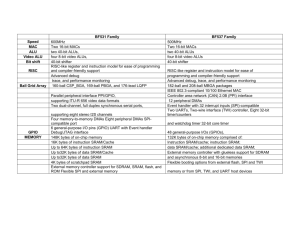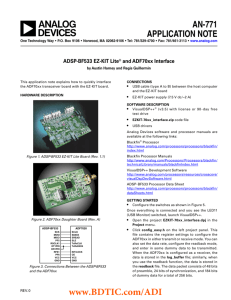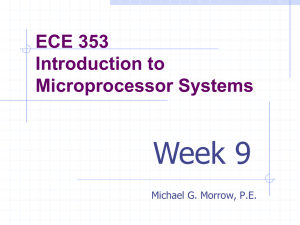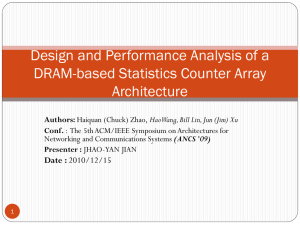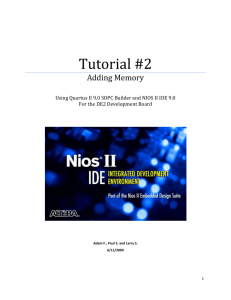display
advertisement
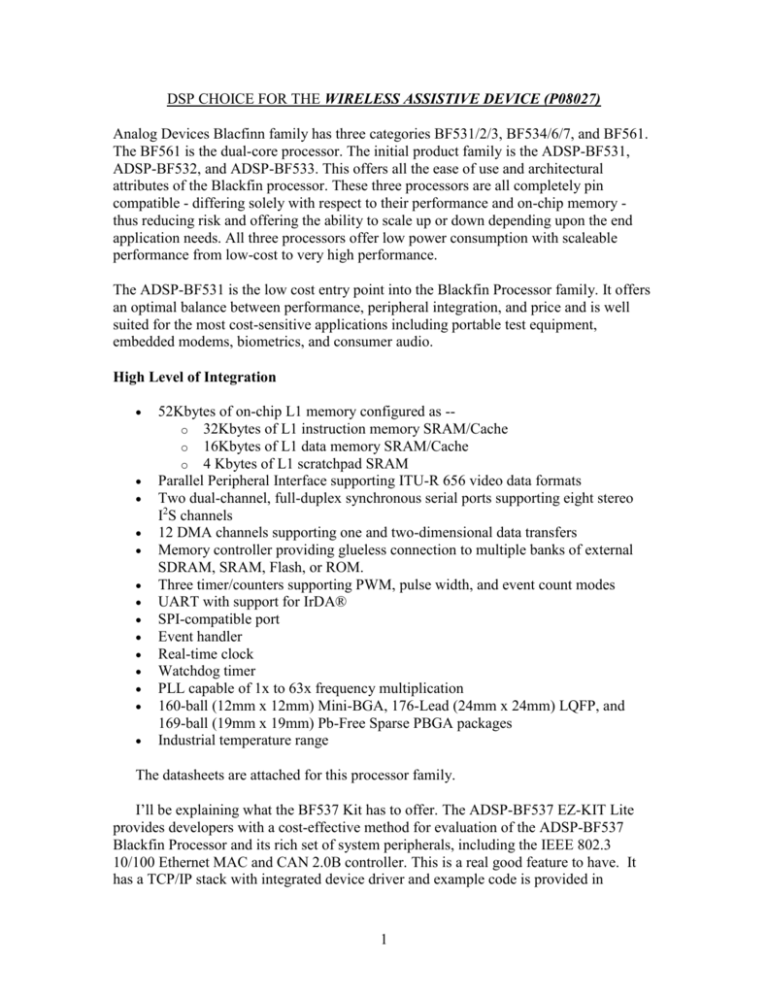
DSP CHOICE FOR THE WIRELESS ASSISTIVE DEVICE (P08027) Analog Devices Blacfinn family has three categories BF531/2/3, BF534/6/7, and BF561. The BF561 is the dual-core processor. The initial product family is the ADSP-BF531, ADSP-BF532, and ADSP-BF533. This offers all the ease of use and architectural attributes of the Blackfin processor. These three processors are all completely pin compatible - differing solely with respect to their performance and on-chip memory thus reducing risk and offering the ability to scale up or down depending upon the end application needs. All three processors offer low power consumption with scaleable performance from low-cost to very high performance. The ADSP-BF531 is the low cost entry point into the Blackfin Processor family. It offers an optimal balance between performance, peripheral integration, and price and is well suited for the most cost-sensitive applications including portable test equipment, embedded modems, biometrics, and consumer audio. High Level of Integration 52Kbytes of on-chip L1 memory configured as -o 32Kbytes of L1 instruction memory SRAM/Cache o 16Kbytes of L1 data memory SRAM/Cache o 4 Kbytes of L1 scratchpad SRAM Parallel Peripheral Interface supporting ITU-R 656 video data formats Two dual-channel, full-duplex synchronous serial ports supporting eight stereo I2S channels 12 DMA channels supporting one and two-dimensional data transfers Memory controller providing glueless connection to multiple banks of external SDRAM, SRAM, Flash, or ROM. Three timer/counters supporting PWM, pulse width, and event count modes UART with support for IrDA® SPI-compatible port Event handler Real-time clock Watchdog timer PLL capable of 1x to 63x frequency multiplication 160-ball (12mm x 12mm) Mini-BGA, 176-Lead (24mm x 24mm) LQFP, and 169-ball (19mm x 19mm) Pb-Free Sparse PBGA packages Industrial temperature range The datasheets are attached for this processor family. I’ll be explaining what the BF537 Kit has to offer. The ADSP-BF537 EZ-KIT Lite provides developers with a cost-effective method for evaluation of the ADSP-BF537 Blackfin Processor and its rich set of system peripherals, including the IEEE 802.3 10/100 Ethernet MAC and CAN 2.0B controller. This is a real good feature to have. It has a TCP/IP stack with integrated device driver and example code is provided in 1 VisualDSP++ release 4.0. This evaluation system was designed with an emphasis on modularity and expandability. Go to www.analog.com for more details on expansion products. With this EZ-KIT Lite, users can learn more about Analog Devices’ ADSPBF537 hardware and software development and quickly prototype applications. Additionally, the ADSP-BF537 EZ-KIT Lite contains the National Instruments Educational Laboratory Virtual Instrumentation Suite (ELVIS) interface. This interface might come in handy with our Data Acquisition Device since, it is also from National Instruments. This interface will allow using the DC voltage and current measurement modules, oscilloscope and bode analyzer modules, function generator, arbitrary waveform generator and digital I/O. NI ELVIS is a LabVIEW-based design and prototype environment for university science and engineering laboratories curriculum. For more details, go to www.ni.com The EZ-KIT Lite includes an ADSP-BF537 Processor desktop evaluation board along with an evaluation suite of the VisualDSP++® development and debugging environment with the C/C++ compiler, assembler, and linker. It also includes sample processor application programs, CE-approved power supply, a USB cable, both straight through and cross-over Ethernet cables, a 3.5mm stereo cable, and a pair of stereo headphones. Speed MAC ALU Video ALU Bit shift RISC Ball Grid Array BF531 Family 600MHz Two 16-bit MACs two 40-bit ALUs, BF537 Family 500MHz Two 16-bit MACs two 40-bit ALUs, four 8-bit video ALUs, 40-bit shifter RISC-like register and instruction model for ease of programming and compiler-friendly support Advanced debug, trace, and performance monitoring 160-ball CSP_BGA, 169-ball PBGA, and 176lead LQFP four 8-bit video ALUs, 40-bit shifter RISC-like register and instruction model for ease of programming and compiler-friendly support Advanced debug, trace, and performance monitoring packages Parallel peripheral interface PPI/GPIO, supporting ITU-R 656 video data formats Two dual-channel, full duplex synchronous serial ports, supporting eight stereo I2S channels Four memory-to-memory DMAs Eight peripheral DMAs SPI-compatible port 6 general-purpose I/O pins (GPIO) UART with 2 182-ball and 208-ball MBGA packages IEEE 802.3-compliant 10/100 Ethernet MAC (ADSP-BF536 and ADSP-BF537 only) Controller area network (CAN) 2.0B interface Parallel peripheral interface (PPI), 12 peripheral DMAs, Event handler with 32 interrupt inputs Serial peripheral interface (SPI)-compatible Two UARTs with IrDA® support Two-wire interface (TWI) controller Eight 32-bit timer/counters with PWM support Real-time clock (RTC) and watchdog timer 32-bit core timer 48 general-purpose I/Os (GPIOs), support for IrDA® Event handler Debug/JTAG interfac MEMORY 148K bytes of on-chip memory 16K bytes of instruction SRAM/Cache Up to 64K bytes of instruction SRAM Up to32K bytes of data SRAM/Cache Up to32K bytes of data SRAM 4K bytes of scratchpad SRAM External memory controller support for SDRAM, SRAM, flash, and ROM Flexible memory booting options from SPI® and external memory 132K bytes of on-chip memory comprised of: Instruction SRAM/cache; instruction SRAM; data SRAM/cache; additional dedicated data SRAM; External memory controller with glueless support for SDRAM and asynchronous 8-bit and 16-bit memories Flexible booting options from external flash, SPI® and TWI memory or from SPI, TWI, and UART host devices In comparing to these Analog Devices processors, Texas Instruments has a wide range of processors. However, none of them are designed for our application. The closes one I could find was MS320C6410/12/13/18 DSPs but it does not suite our application. Also, most of the range of Processors in this family is much slower than the Blackfinn processors. Only the high end processors are fast enough; but since they are the high end processors; their development boards also could be a little bit more expensive. Although; we are getting student discounts for these boards from a distributor, I’m sure we’ll need to spend more for these boards. I’m sure we get the job done with these boards; however, I’m not sure how efficient their support services could be, also the Blackfinn is the new line of DSP processors so we should be getting plenty of support from them. Also I know someone who recently finished their COOP at Analog Devices, so I’m sure we can get a good deal. The other problem is that Analog Devices comes with its IDE called Visual DSP, which is supposed to be pretty good, I’m not sure how great TI’s IDE (CCS- Code Compressor Studio) is. I've looked at TI's DSP processors, but they are all designed for video, audio, or wireless process exclusively. Blackfinn offers us flexibility that I did not find in TI. Also, these are just my intuitions from research; we can further consult Dr. Philips before we place our order. If the costs for both are the same, I’ll recommend we go with the Blackfinn processors. References: http://focus.ti.com/paramsearch/docs/parametricsearch.tsp?family=dsp&sectionId=2&tab Id=1941&familyId=1398 www.analog.com 3
